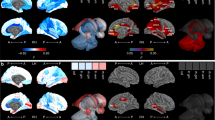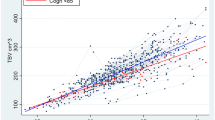Abstract
Background
Altered brain volumes and associations between volumes and developmental outcomes have been reported in prematurely born children.
Objectives
To assess which regional brain volumes are different in very low birth weight (VLBW) children without neurodevelopmental impairments ([NDI] cerebral palsy, hearing loss, blindness and significantly delayed cognitive performance) compared with VLBW children with NDI, and to evaluate the association between regional brain volumes at term-equivalent age and cognitive development and neurological performance at a corrected age of 2 years.
Materials and methods
The study group consisted of a regional cohort of 164 VLBW children, divided into one group of children without NDI (n = 148) and one group of children with NDI (n = 16). Brain (MRI) was performed at term-equivalent age, from which brain volumes were manually analysed. Cognitive development was assessed with the Bayley Scales of Infant Development II (BSID-II), and neurological performance with the Hammersmith Infant Neurological Examination at the corrected age of 2 years.
Results
The volumes of total brain tissue, cerebrum, frontal lobes, basal ganglia and thalami, and cerebellum were significantly smaller, and the volume of the ventricles significantly larger, in the children with NDI than in those without NDI. Even in children without NDI, a smaller cerebellar volume was significantly correlated with poor neurological performance at 2 years of corrected age.
Conclusion
Volumetric analysis at brain MRI can provide an additional parameter for early prediction of outcome in VLBW children.


Similar content being viewed by others
References
Inder TE, Warfield SK, Wang H et al (2005) Abnormal cerebral structure is present at term in premature infants. Pediatrics 115:286–294
Peterson BS, Anderson AW, Ehrenkranz R et al (2003) Regional brain volumes and their later neurodevelopmental correlates in term and preterm infants. Pediatrics 111:939–948
Shah DK, Anderson PJ, Carlin JB et al (2006) Reduction in cerebellar volumes in preterm infants: Relationship to white matter injury and neurodevelopment at two years of age. Pediatr Res 60:97–102
Shah DK, Guinane C, August P et al (2006) Reduced occipital regional volumes at term predict impaired visual function in early childhood in very low birth weight infants. Invest Ophthalmol Vis Sci 47:3366–3373
Woodward LJ, Edgin JO, Thompson D et al (2005) Object working memory deficits predicted by early brain injury and development in the preterm infant. Brain 128:2578–2587
Allin M, Matsumoto H, Santhouse AM et al (2001) Cognitive and motor function and the size of the cerebellum in adolescents born very pre-term. Brain 124:60–66
Allin MP, Salaria S, Nosarti C et al (2005) Vermis and lateral lobes of the cerebellum in adolescents born very preterm. Neuroreport 16:1821–1824
Peterson BS, Vohr B, Staib LH et al (2000) Regional brain volume abnormalities and long-term cognitive outcome in preterm infants. JAMA 284:1939–1947
Nosarti C, Rushe TM, Woodruff PW et al (2004) Corpus callosum size and very preterm birth: relationship to neuropsychological outcome. Brain 127:2080–2089
Rademaker KJ, Lam JN, Van Haastert IC et al (2004) Larger corpus callosum size with better motor performance in prematurely born children. Semin Perinatol 28:279–287
Isaacs EB, Lucas A, Chong WK et al (2000) Hippocampal volume and everyday memory in children of very low birth weight. Pediatr Res 47:713–720
Reiss AL, Kesler SR, Vohr B et al (2004) Sex differences in cerebral volumes of 8-year-olds born preterm. J Pediatr 145:242–249
Nosarti C, Giouroukou E, Healy E et al (2008) Grey and white matter distribution in very preterm adolescents mediates neurodevelopmental outcome. Brain 131:205–217
Yung A, Poon G, Qiu DQ et al (2007) White matter volume and anisotropy in preterm children: a pilot study of neurocognitive correlates. Pediatr Res 61:732–736
Abernethy LJ, Cooke RW, Foulder-Hughes L (2004) Caudate and hippocampal volumes, intelligence, and motor impairment in 7-year-old children who were born preterm. Pediatr Res 55:884–893
Nosarti C, Allin MP, Frangou S et al (2005) Hyperactivity in adolescents born very preterm is associated with decreased caudate volume. Biol Psychiatry 57:661–666
Kesler SR, Ment LR, Vohr B et al (2004) Volumetric analysis of regional cerebral development in preterm children. Pediatr Neurol 31:318–325
Papile LA, Burstein J, Burstein R et al (1978) Incidence and evolution of subependymal and intraventricular hemorrhage: A study of infants with birth weights less than 1,500 gm. J Pediatr 92:529–534
de Vries LS, Eken P, Dubowitz LM (1992) The spectrum of leukomalacia using cranial ultrasound. Behav Brain Res 49:1–6
Virkola K (1988) The lateral ventricle in early infancy. Dissertation, University of Helsinki, Helsinki
Rademaker KJ, Uiterwaal CS, Beek FJ et al (2005) Neonatal cranial ultrasound versus MRI and neurodevelopmental outcome at school age in children born preterm. Arch Dis Child Fetal Neonatal Ed 90:F489–F493
Bayley N (1993) Bayley Scales of Infant Development, 2nd edn. Psychological Corporation, San Antonio
Haataja L, Mercuri E, Regev R et al (1999) Optimality score for the neurologic examination of the infant at 12 and 18 months of age. J Pediatr 135:153–161
Frisone MF, Mercuri E, Laroche S et al (2002) Prognostic value of the neurologic optimality score at 9 and 18 months in preterm infants born before 31 weeks’ gestation. J Pediatr 140:57–60
Romeo DM, Guzzetta A, Scoto M et al (2008) Early neurologic assessment in preterm-infants: integration of traditional neurologic examination and observation of general movements. Eur J Paediatr Neurol 12:183–189
Haataja L, Mercuri E, Guzzetta A et al (2001) Neurologic examination in infants with hypoxic-ischemic encephalopathy at age 9 to 14 months: Use of optimality scores and correlation with magnetic resonance imaging findings. J Pediatr 138:332–337
Haataja L, Cowan F, Mercuri E et al (2003) Application of a scorable neurologic examination in healthy term infants aged 3 to 8 months. J Pediatr 143:546
Himmelmann K, Hagberg G, Beckung E et al (2005) The changing panorama of cerebral palsy in sweden. IX. prevalence and origin in the birth-year period 1995–1998. Acta Paediatr 94:287–294
Bax M, Goldstein M, Rosenbaum P et al (2005) Proposed definition and classification of cerebral palsy, April 2005. Dev Med Child Neurol 47:571–576
Shrout PE, Fleiss JL (1978) Intraclass correlations: uses in assessing rater reliability. Psychol Bull 86:420–428
Volpe JJ (2009) Cerebellum and the premature infant: rapidly developing, vulnerable, clinically important. J Child Neurol 24:1085–1104
Srinivasan L, Dutta R, Counsell SJ et al (2007) Quantification of deep gray matter in preterm infants at term-equivalent age using manual volumetry of 3-Tesla magnetic resonance images. Pediatrics 119:759–765
Boardman JP, Counsell SJ, Rueckert D et al (2006) Abnormal deep grey matter development following preterm birth detected using deformation-based morphometry. Neuroimage 32:70–78
Voss W, Neubauer AP, Wachtendorf M et al (2007) Neurodevelopmental outcome in extremely low birth weight infants: what is the minimum age for reliable developmental prognosis? Acta Paediatr 96:342–347
Woodward LJ, Anderson PJ, Austin NC et al (2006) Neonatal MRI to predict neurodevelopmental outcomes in preterm infants. N Engl J Med 355:685–694
Dyet LE, Kennea N, Counsell SJ et al (2006) Natural history of brain lesions in extremely preterm infants studied with serial magnetic resonance imaging from birth and neurodevelopmental assessment. Pediatrics 118:536–548
Spittle AJ, Brown NC, Doyle LW et al (2008) Quality of general movements is related to white matter pathology in very preterm infants. Pediatrics 121:e1184–e1189
Hack M, Taylor HG, Drotar D et al (2005) Poor predictive validity of the Bayley Scales of Infant Development for cognitive function of extremely low birth weight children at school age. Pediatrics 116:333–341
Salt A, Redshaw M (2006) Neurodevelopmental follow-up after preterm birth: Follow up after two years. Early Hum Dev 82:185–197
Ment LR, Vohr B, Allan W et al (2003) Change in cognitive function over time in very low-birth-weight infants. JAMA 289:705–711
Reiss AL, Abrams MT, Singer HS et al (1996) Brain development, gender and IQ in children. A volumetric imaging study. Brain 119:1763–1774
Acknowledgements
The PIPARI Study Group: Satu Ekblad, R.N.; Eeva Ekholm, M.D., Ph.D.; Leena Haataja, M.D., Ph.D.; Mira Huhtala, M.D.; Pentti Kero, M.D., Ph.D.; Riikka Korja, Phil.Lic.; Harry Kujari, M.D.; Helena Lapinleimu M.D., Ph.D.; Liisa Lehtonen, M.D., Ph.D.; Marika Leppänen, B.M.; Hanna Manninen, M.D.; Jaakko Matomäki, M.Sc.; Jonna Maunu, M.D.; Petriina Munck, M.A.; Pekka Niemi, Ph.D.; Pertti Palo, M.D., Ph.D.; Riitta Parkkola, M.D., Ph.D.; Jorma Piha, M.D., Ph.D.; Annika Lind, M.A.; Liisi Rautava, M.D.; Päivi Rautava, M.D., Ph.D.; Milla Reiman, M.D.; Hellevi Rikalainen, M.D.; Katriina Saarinen, Physiotherapist; Elina Savonlahti, M.D.; Matti Sillanpää, M.D., Ph.D.; Suvi Stolt, Phil.Lic.; Päivi Tuomikoski-Koiranen, R.N.; Tuula Äärimaa, M.D., Ph.D.
This study was financially supported by grants from the Academy of Finland/Research Programme on Neuroscience, Foundation for Paediatric Research/The South-Western Finnish Foundation of Neonatal Research, The Päivikki and Sakari Sohlberg Foundation and The Signe and Ane Gyllenberg Foundation.
Author information
Authors and Affiliations
Consortia
Corresponding author
Rights and permissions
About this article
Cite this article
Lind, A., Parkkola, R., Lehtonen, L. et al. Associations between regional brain volumes at term-equivalent age and development at 2 years of age in preterm children. Pediatr Radiol 41, 953–961 (2011). https://doi.org/10.1007/s00247-011-2071-x
Received:
Revised:
Accepted:
Published:
Issue Date:
DOI: https://doi.org/10.1007/s00247-011-2071-x




